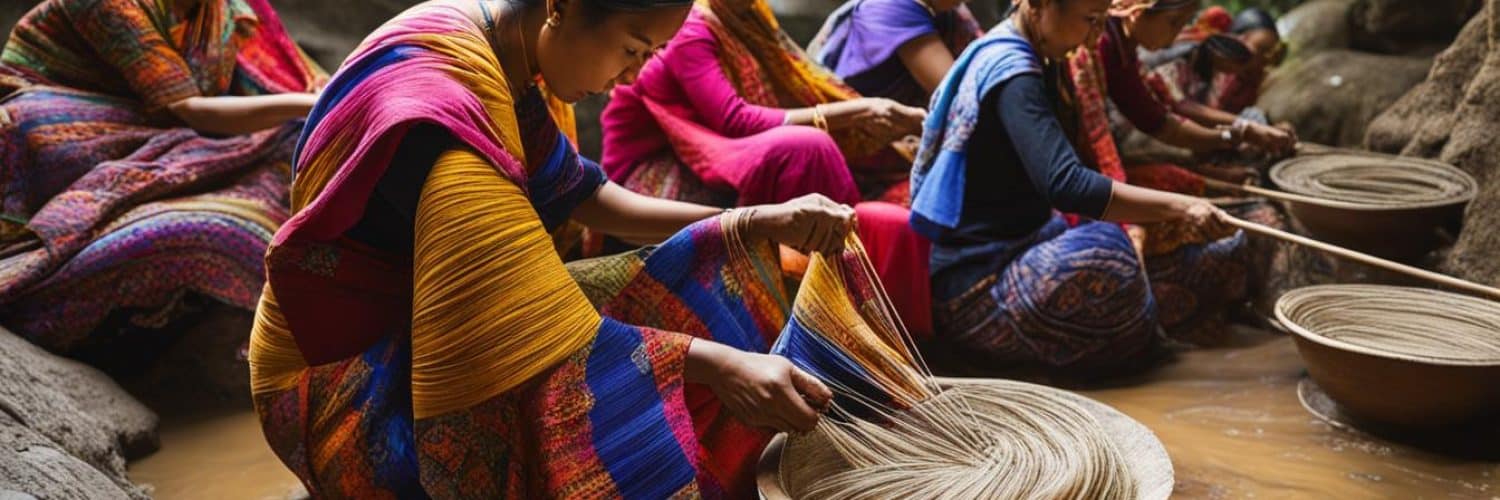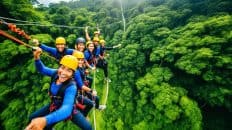Saob Cave in Samar, Philippines is a haven for the talented women weavers who gather beneath its limestone rock formation to practice the art of traditional weaving. Nestled in the cool and serene cave environment, these women showcase their craftsmanship and preserve the indigenous culture of Samar through their intricate handwoven textiles.
Key Takeaways:
- Explore the weaving heritage of Saob Cave in Samar, Philippines
- Witness the intricate traditional weaving techniques passed down through generations
- Understand the importance of preserving and promoting indigenous weaving culture
- Discover the impact of training programs on the livelihood of the women weavers
- Experience the economic and social empowerment of women through weaving
The Weaving Process at Saob Cave
The women weavers at Saob Cave follow the traditional weaving techniques that have been passed down through generations. To create their exquisite handwoven textiles, they skillfully work with locally harvested tikog and buri grass.
The process of weaving at Saob Cave involves cutting and dying the grass, preparing the materials for embroidery, and skillfully weaving the mats. With every intricate design and pattern, the weavers showcase their expertise and dedication to the art of traditional weaving.
The traditional weaving process at Saob Cave is a labor of love that requires time, patience, and meticulous attention to detail. Each step in the process contributes to the creation of unique and beautiful handwoven textiles that reflect the rich cultural heritage of Samar.
Throughout the weaving process, the women weavers demonstrate their skill in selecting the finest grass, dyeing it with vibrant and natural colors, and meticulously weaving the mats. The result is a collection of handwoven textiles that are not only visually stunning but also durable and of exceptional quality.
By preserving and continuing the tradition of traditional weaving, the women weavers at Saob Cave not only create exquisite handwoven textiles but also contribute to the preservation of their indigenous culture and heritage.
Importance of Weaving Preservation
The cultural heritage of the region is intricately woven into the art of traditional weaving. This ancient craft not only reflects the indigenous culture of Samar but also serves as a testament to the resilience and creativity of its people. However, in the face of modernization and changing times, the preservation of traditional weaving practices becomes crucial in safeguarding this valuable intangible heritage.
By engaging in initiatives like the training programs at Saob Cave, the women weavers are playing a vital role in protecting and preserving the weaving industry. These programs serve as a platform for knowledge transfer, ensuring that the art of traditional weaving is handed down to future generations. Through their dedication and commitment, the women weavers uphold the cultural significance of their craft, keeping the flame of their indigenous culture alive.
“Traditional weaving is not just a means of livelihood for us; it is a way to connect with our ancestors and the roots of our heritage. Weaving is a language that speaks of our identity and our pride as Samar’s cultural bearers.”
Preserving traditional weaving not only safeguards the cultural heritage of the region but also strengthens the social fabric of the community. By empowering the women weavers and supporting their craft, these initiatives contribute to women’s economic independence and overall community development. The weaving industry serves as a source of pride, attracting visitors from far and wide who seek an authentic cultural experience.
Table: Economic Impact of Weaving Industry
| Impact | Description |
|---|---|
| Income Generation | The weaving industry provides a stable source of income for the women weavers and their families, contributing to poverty alleviation and economic growth in the community. |
| Empowerment | By earning a fair wage through their craft, the women weavers experience increased financial independence and empowerment, leading to improved social standing and well-being. |
| Community Development | The revenue generated from the sale of handwoven textiles supports the development of infrastructure, education, and healthcare facilities in the area, fostering overall community progress. |
Preserving traditional weaving is not just about keeping a centuries-old craft alive. It is about honoring the invaluable legacy left by our ancestors and ensuring that future generations can continue to experience the beauty and richness of our indigenous culture. By supporting the women weavers and their initiatives, we contribute to the sustainable development of the weaving industry and the preservation of Samar’s cultural heritage.
Continue Reading: Training Programs for the Weavers
Training Programs for the Weavers
The women weavers at Saob Cave are dedicated to honing their skills and passing down the art of traditional weaving to future generations. To achieve this, they actively participate in training programs that equip them with new techniques and knowledge.
BAYAN ACADEMY/WOVEN’s 10-day training program is one such initiative that offers comprehensive skills training to both experienced weavers and young apprentices. Through this program, the weavers gain valuable insights into various aspects of the weaving process, from start to finish.
Participants in the training program are guided through each step of the weaving process, including:
- Cutting and dying the materials: Weavers learn how to select and prepare the grass and other materials used in weaving. They discover various dyeing techniques that enhance the beauty of their creations.
- Embroidery techniques: Weavers develop their embroidery skills, acquiring expertise in creating intricate designs and patterns on their handwoven textiles. This attention to detail adds a unique touch to their finished products.
- Weaving methods: Weavers learn different weaving methods, mastering both basic and advanced techniques. They gain a deep understanding of the loom and its components, enabling them to create diverse and intricate weaves.
These training programs have proven to be instrumental in preserving the craft of traditional weaving and empowering the women weavers of Saob Cave. By investing in their training and education, the community ensures the sustainability of the weaving industry and empowers its artisans.
Economic Impact of Weaving Industry
The livelihood of the community in Basey, Samar, is greatly influenced by the weaving industry. The production and sale of handwoven textiles provide a valuable source of income for the weavers and their families. This economic contribution not only supports their daily needs but also improves their overall quality of life.
One of the key initiatives that has positively impacted the economic aspect of the weaving industry is Woven PH. Through this organization, the weavers have experienced a significant increase in their earnings. From an average monthly income of P150, the weavers can now earn around P4,000 to P5,000. This substantial increase in income has enabled them to thrive and secure a better livelihood.
The economic impact of the weaving industry extends beyond the weavers themselves. As the industry grows and flourishes, it generates employment opportunities for various individuals, such as suppliers of raw materials and manufacturers of weaving equipment. This ripple effect contributes to the overall economic growth of the community and creates a positive cycle of development.
Additionally, tourism plays a crucial role in boosting the local economy. Visitors are drawn to Basey, Samar, to witness the artistry of the women weavers at Saob Cave. This influx of tourists results in increased business for local establishments, including hotels, restaurants, and souvenir shops. The weaving industry acts as a catalyst for tourism, driving economic growth and providing additional livelihood opportunities for the community.
Socioeconomic Benefits of the Weaving Industry
The economic impact of the weaving industry goes beyond financial gains. It has profound socioeconomic benefits for the community. By supporting the weaving industry, individuals can contribute to the preservation of cultural heritage and indigenous traditions, ensuring the continuity of the weaving craft for future generations. This cultural preservation brings a sense of pride and identity to the community, fostering a strong sense of belonging and unity.
Furthermore, the weaving industry empowers women weavers by providing them with a means to earn a living and become financially independent. It allows them to participate actively in decision-making processes and play significant roles in shaping their community’s future. This empowerment contributes to gender equality and social progress, promoting a more inclusive and equitable society.
Economic Impact Table
| Impact | Data |
|---|---|
| Increased weavers’ monthly income | P4,000 to P5,000 |
| Employment opportunities in the industry | Suppliers, manufacturers, tourism-related businesses |
| Tourism revenue | Growth in local businesses |
| Socioeconomic benefits | Cultural preservation, women empowerment, social progress |
Recognition and Promotion of Weaving Culture
Efforts have been made to recognize and promote the weaving culture of Basey, Samar. Organizations like Woven PH have played a crucial role in showcasing the talent and creativity of the women weavers through product development, collaboration with artists, and market access. By providing a platform for the weavers to showcase their handwoven products, the cultural heritage of the weaving culture is celebrated and preserved.
The collaboration between organizations and the women weavers has led to the development of unique and innovative products that combine traditional weaving techniques with contemporary designs. This fusion of tradition and modernity not only appeals to a wider audience but also ensures the relevance and sustainability of the weaving craft.
“Weaving is not just a craft; it is a way of life for us. Through our collaborations with Woven PH and other partners, we have been able to showcase our weaving skills and cultural heritage to the world. This recognition and promotion have given us a sense of pride and an opportunity to preserve our traditions for future generations.” – Maria Santos, a master weaver at Saob Cave
Market access is another crucial aspect of promoting the weaving culture. Through marketing initiatives, such as online platforms and participation in local and international trade fairs, the women weavers gain visibility and recognition. These opportunities not only generate income but also create awareness and appreciation for the skill and craftsmanship behind the handwoven textiles.
The recognition and promotion of the weaving culture in Basey, Samar contribute to the economic empowerment of the women weavers and the overall development of the community. By valuing and supporting the weaving industry, we ensure the continued preservation of this rich cultural heritage and provide avenues for the sustainable growth of the women’s livelihoods.
Key Highlights:
- Organizations like Woven PH have played a crucial role in showcasing the talent and creativity of the women weavers.
- Collaboration with artists and market access have been instrumental in promoting the weaving craft.
- Market initiatives like online platforms and trade fairs generate income and create awareness for handwoven textiles.
- The recognition and promotion of the weaving culture empower the women weavers and contribute to the community’s development.
Visitors’ Experience at Saob Cave
When it comes to Samar tourism, a visit to Saob Cave is a must for travelers. This unique destination offers a truly immersive experience where visitors can witness the incredible artistry of the women weavers firsthand.
As you step into the cave, you’ll be captivated by the tranquil and cool environment that surrounds you. It’s the perfect setting to deeply appreciate and understand the weaving culture that has been passed down through generations.
One of the highlights of the visitors’ experience at Saob Cave is the opportunity to observe the women weavers as they skillfully create their handwoven products. You can see the intricate weaving techniques up close, marvel at the precision and creativity that goes into each piece, and gain a deeper appreciation for the art form.
The interaction with the weavers themselves is also a memorable part of the experience. You can engage in conversations, learn their stories, and hear about the rich cultural heritage they are preserving. It’s a chance to connect with the local community and gain insights into their way of life.
No visit is complete without taking home a piece of the weaving culture. Saob Cave offers visitors the opportunity to purchase the handwoven products as souvenirs. From delicate mats to intricate textiles, you can bring back a unique piece of Samar’s weaving tradition and support the local artisans in their livelihood.
With its picturesque surroundings and the awe-inspiring talent of the women weavers, Saob Cave provides an unforgettable experience for travelers. It’s a chance to immerse yourself in the beauty of traditional weaving, connect with the local community, and contribute to the preservation of Samar’s indigenous culture.
Testimonials
“Visiting Saob Cave was a truly memorable experience. I was amazed by the skill and artistry of the women weavers. Interacting with them and witnessing their craft up close gave me a deeper appreciation for the weaving culture in Samar.”
– Jane, Traveler
“Saob Cave provides a unique opportunity to support local artisans while experiencing the beauty of traditional weaving. I cherish the handwoven product I purchased and the memories of my visit to this enchanting destination.”
– Mark, Adventurer
Collaborations and Social Impact
Collaborations between organizations, artists, and the community have had a significant social impact on the women weavers of Basey, Samar. These collaborations have empowered the weavers by providing them with fair wages, market opportunities, and exposure to a wider audience. By valuing their craft and supporting their livelihood, these initiatives contribute to the empowerment and economic independence of the women weavers.
| Collaborations | Social Impact |
|---|---|
| Partnerships with local organizations | Enhanced visibility and market access |
| Collaborative projects with artists | Exposure to a wider audience and increased recognition |
| Community-driven initiatives | Preservation of indigenous weaving culture and traditions |
Through collaboration, the women weavers are able to expand their reach and impact. By joining forces with local organizations, they gain access to new markets and resources that help them sustain their livelihoods. Collaborative projects with artists provide opportunities for creative expression and bring attention to the unique skill and artistry of the weavers. Additionally, community-driven initiatives not only preserve the indigenous weaving culture but also empower the weavers by fostering a sense of pride and cultural identity.
“Weaving is not just about creating beautiful textiles; it’s about preserving our cultural heritage and empowering women. Through collaboration, we have been able to uplift the lives of the weavers and ensure the sustainability of our craft.” – Maria Santos, President of Weavers’ Cooperative
These collaborations have a profound social impact, not only on the weavers themselves but also on the wider community. By valuing the work of the women weavers and providing fair wages, these initiatives contribute to women empowerment and gender equality. The economic independence gained through their craft allows the weavers to support their families and invest in education and healthcare. By supporting the weavers and their traditional craft, collaborations promote cultural preservation, local heritage, and sustainable development.
Future Outlook and Sustainability
The future of the weaving industry in Basey, Samar relies on the sustainability of the craft. Continued support, training programs, and market access are crucial in ensuring the growth and preservation of the weaving culture for future generations. Women weavers at Saob Cave play a vital role in securing the future of their craft by passing on their knowledge and skills to younger generations.
The preservation of traditional weaving is not only important for cultural preservation but also for the livelihoods of the community. By investing in training programs and providing market opportunities, the weaving industry can continue to thrive and contribute to the economic growth of Basey, Samar.
Training the Next Generation
Passing down the art of traditional weaving to younger generations is essential for its continuity. By engaging young apprentices and providing them with formal training, the women weavers ensure that the craft will be sustained for years to come. These programs not only teach the weaving techniques but also instill a sense of pride and cultural appreciation in the future weavers.
Through these training programs, the women weavers empower the next generation, giving them the skills and knowledge to earn a livelihood and preserve their cultural heritage. By honing their craft and expanding their market reach, the women weavers open up opportunities for sustainable economic growth in the community.
Market Access and Sustainability
Ensuring market access is another crucial aspect of weaving sustainability. In order for the industry to thrive, the handwoven products of the women weavers need to reach a wider audience. Collaborations with organizations and initiatives that promote traditional crafts play a vital role in providing market access to the women weavers.
By showcasing their products and connecting them with customers, these collaborations contribute to the economic sustainability of the weaving industry. Moreover, by increasing the demand for handwoven textiles, these initiatives create a positive cycle that promotes the growth and preservation of the craft.
Preserving Cultural Heritage
Preservation of cultural heritage is at the core of weaving sustainability. By continuing to practice the art of traditional weaving, the women weavers keep alive the rich cultural heritage of Basey, Samar. These handwoven textiles not only represent the skill and craftsmanship of the weavers but also tell the stories and traditions of the indigenous culture.
Supporting the weaving industry is not just about preserving the craft but also about honoring the cultural identity of the community. By valuing and promoting their artistry, we ensure that future generations can experience and appreciate the beauty of traditional weaving.
Tourism and Community Development
The weaving industry in Basey, Samar has had a significant impact on the community’s development. The increase in tourism, driven by visitors coming to witness the women weavers at Saob Cave, has played a crucial role in the local economy and overall growth of the community. This thriving industry has become a source of pride for the residents and has brought attention to the cultural heritage of the region.
With its unique weaving tradition, Basey, Samar has attracted tourists from near and far. These visitors not only contribute to the local economy by engaging in tourism-related activities but also support the women weavers through the purchase of their handwoven products. The sustainable growth of the weaving industry has positively influenced the livelihoods of the weavers and the entire community, fostering economic growth and prosperity.
The economic impact of tourism extends beyond the weavers themselves. It stimulates the growth of related industries, such as hospitality, transportation, and local businesses. As tourism flourishes, new job opportunities are created, leading to increased employment rates and improved living conditions for the community.
The weaving industry has encouraged community development by fostering a sense of pride and preserving the cultural heritage of Basey, Samar. The local residents actively engage in the promotion and preservation of their weaving culture, ensuring that future generations can continue to experience and appreciate this invaluable tradition.
Sustainable Tourism and Weaving Industry
Sustainable tourism practices go hand in hand with the preservation and growth of the weaving industry in Basey, Samar. It is essential to strike a balance between tourism development and the protection of the environment and local culture. Community-based tourism initiatives have been implemented to ensure that tourism benefits both the visitors and the host community by promoting responsible travel practices and minimizing negative impacts on the environment.
The community, together with local authorities and organizations, has taken steps to manage tourism flows effectively. This includes implementing carrying capacity measurements, promoting cultural sensitivity, and establishing guidelines for responsible tourist behavior in and around Saob Cave. By maintaining a sustainable approach to tourism, the community can ensure the preservation of its natural and cultural treasures for future generations.
| Benefits of Tourism for Community Development | Challenges for Community Development |
|---|---|
|
|
“Tourism should not be seen as an isolated industry, but as an integral part of the community’s development plan. By harnessing the potential of tourism while addressing its challenges, Basey, Samar can create a sustainable future for both the weaving industry and the community as a whole.” – Local Tourism Development Officer
Conclusion
Saob Cave in Samar, Philippines is home to a group of talented women weavers who are dedicated to preserving and promoting the art of traditional weaving. Through their craftsmanship, these women have not only preserved the cultural heritage of the region but also provided economic opportunities for the community.
By supporting the women weavers and experiencing their work firsthand, visitors play a crucial role in the sustainability and growth of the weaving industry in Basey, Samar. Watching the women weavers at Saob Cave showcases the beauty and intricacy of traditional weaving, allowing visitors to appreciate the indigenous culture that thrives in this area of the Philippines.
From the preparation of materials to the weaving process itself, the women weavers at Saob Cave demonstrate remarkable skill and creativity. Each handwoven textile represents a piece of their heritage, passed down through generations. By immersing themselves in the world of these talented artisans, visitors contribute to the preservation of this ancient art form and support the livelihood of the women weavers.
FAQ
How can I experience the women weavers at Saob Cave in Samar?
To experience the women weavers at Saob Cave, you can visit the cave and observe the weaving process firsthand. You can also interact with the weavers and purchase their handwoven products as souvenirs.
What materials do the women weavers at Saob Cave use?
The women weavers at Saob Cave use tikog and buri grass, which are locally harvested, for their weaving. They cut and dye the grass, prepare the materials for embroidery, and weave the mats using traditional techniques.
Why is the preservation of traditional weaving important?
The preservation of traditional weaving is important because it helps to safeguard the cultural heritage of the region. It also ensures the continuity of the craft and the economic opportunities it provides for the community.
Are there any training programs available for the weavers at Saob Cave?
Yes, there are training programs available for the weavers at Saob Cave. Organizations like BAYAN ACADEMY/WOVEN offer 10-day training programs that cover cutting and dyeing materials, embroidery techniques, and weaving methods.
How does the weaving industry impact the local economy?
The weaving industry in Basey, Samar has a significant economic impact. By providing a source of income through the production and sale of handwoven textiles, it supports the livelihood of the weavers and contributes to the overall growth of the community.
How is the weaving culture of Basey, Samar recognized and promoted?
The weaving culture of Basey, Samar is recognized and promoted through initiatives like Woven PH. These organizations collaborate with artists, develop new products, and provide market access for the women weavers to showcase their talent and creativity.
What can visitors expect when visiting Saob Cave?
Visitors to Saob Cave can expect to witness the artistry of the women weavers firsthand. They can observe the weaving process, interact with the weavers, and purchase handwoven products as souvenirs. The tranquil environment of the cave enhances the overall experience.
How do collaborations impact the women weavers of Basey, Samar?
Collaborations between organizations, artists, and the community empower the women weavers by providing them with fair wages, market opportunities, and exposure to a wider audience. These collaborations contribute to the women’s empowerment and economic independence.
What is the future outlook for the weaving industry in Basey, Samar?
The future outlook for the weaving industry in Basey, Samar relies on the sustainability of the craft. Continued support, training programs, and market access are essential in ensuring the growth and preservation of the weaving culture for future generations.
How does the weaving industry impact community development?
The weaving industry in Basey, Samar has had a positive impact on community development. It has increased tourism, contributed to the local economy, and brought attention to the cultural heritage of the region. The industry has become a source of pride for the residents.
Can I support the women weavers at Saob Cave?
Yes, you can support the women weavers at Saob Cave by visiting the cave, purchasing their handwoven products, and spreading awareness about their craft. Your support helps to sustain the weaving industry and preserve the cultural heritage of Basey, Samar.


















Add comment